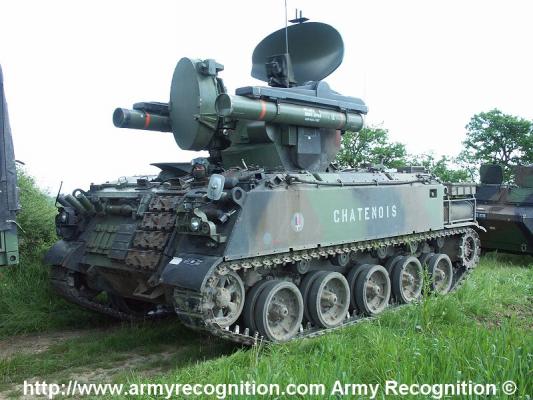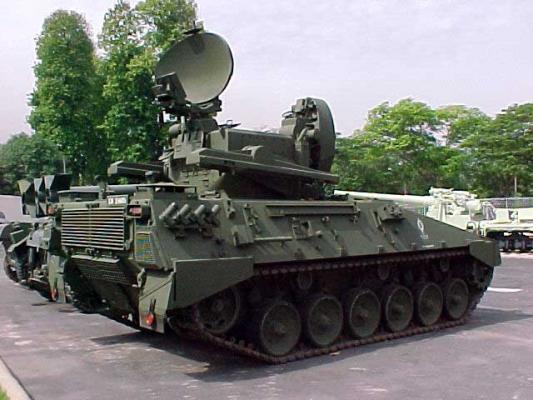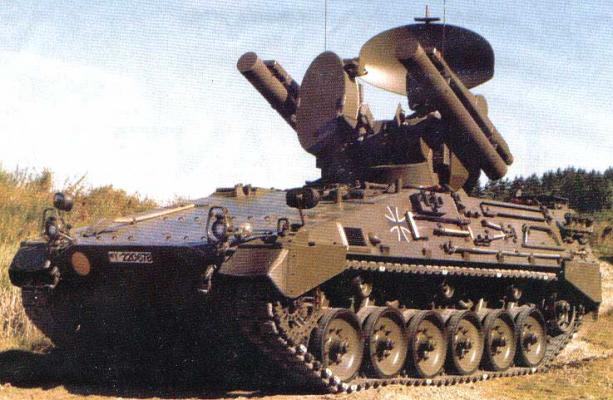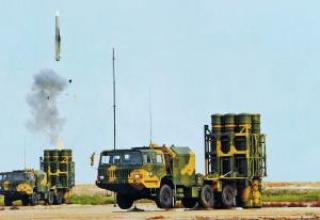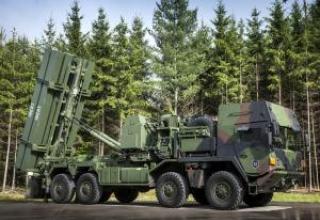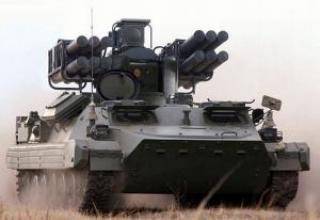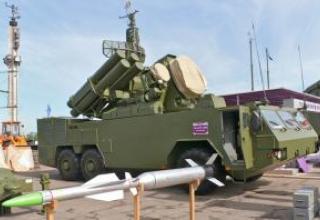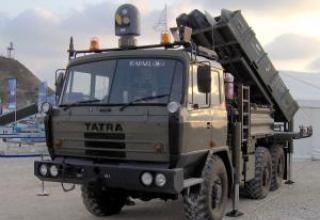All-weather self-propelled anti-aircraft missile system "Roland-2" with a radar tracking system for target and missile tracking was developed by the company "Messerchmitt-Bolkow-Blohm" (Germany) together with "Aerospatiale-Matra" (France) and is capable of destroying targets flying at speeds up to M=1.2 at altitudes from 15m to 5.5 km and ranges from 500m to 6.3 km. Originally the complex was designed to meet the needs of the Bundeswehr, however, due to the obvious advantage of the new complex over the previously released Roland-1 SAM system, the French Army command decided to convert part of its Roland-1 systems into the Roland-2 version. Such a possibility was envisaged by the developers even at the stage of the complex creation.
The complex was widely exported and in various variants is in service with the armies of France, Germany, Argentina, Brazil, Nigeria, Qatar, Spain and Venezuela. One such variant is the Roland-2C air defense system developed by order of the Belgian Ministry of Defence for air defense of stationary objects located in the theater of war (airfields, bridges, warehouses, etc.). Unlike "Roland-2" SAM system, in which all equipment is located on one tracked chassis, "Roland-2c" complex consists of a command post and launcher, placed on the chassis of the car "Berlie" (6X6), which has high cross-country ability. The use of this base allows the rapid transfer of SAMs over long distances on an equipped TVD.
In 1975, the USA decided to develop the American version of "Roland-2". Based on the results of comparative tests it was given preference over Crotale (France) and Rapier (Great Britain) SAMs. However, having spent about $300 million on R&D, the program managers in 1981 had to give up its continuation, referring to the difficulties in achieving a number of characteristics of SAM subsystems to American standards and unacceptably high cost of the complex production in the USA. In 1983, 27 serial models of SAM systems with 595 missiles produced by that time were handed over to equip one of the anti-aircraft divisions of the National Guard, but already in 1988 they were replaced by Chapparal's SAM systems due to high operating costs.
Since the release of the first versions of the "Roland" SAM system has been repeatedly upgraded in order to improve combat capabilities, transfer control equipment to a modern element base, etc.. At present the last variant of "Roland" family is in production - "Roland-3" SAM system.
Composition:
Roland-2" SAM system can be placed on different chassis: in the French Armed Forces - the chassis of the medium tank AMX-30, in the Bundeswehr - the chassis of the infantry fighting vehicle "Marder" (scheme), in the U.S. National Guard - the chassis of the armored vehicle M-109 (later M812A1). The combat calculation of the SAM consists of three persons: the driver, commander and operator.
The layout of the Roland-2" SAM system (see the schematic) is generally similar to that of the "Roland-1" SAM system. On the unified rotating tower are installed: beams to accommodate missiles, radar antenna detection, radar antenna to escort the target and missiles, optical and infrared tracking systems and antenna command transmitter. Inside the casing of the launcher mounted transmitters and receivers of the target detection radar and target and missile tracking radar, counting and resolution device, remote control, two revolver magazines with eight missiles in transport and launch containers, a radio station, instrumentation and power supply. Beam holders with containers in the angular plane are automatically guided through the target tracking line, in the azimuth plane - by turning the tower.
Roland-2" differs from its prototype by the presence of target tracking radars and missiles, which ensure the functioning of the complex at any time of day regardless of weather conditions.
Roland-2" SAM system fires the same missiles as "Roland-1". The solid-propellant missile has an empty weight of 62.5 kg and weighs 6.5 kg, including 3.3 kg of explosives. In addition to the contact fuse, the BC also has a radio detonator, which provides firing at a distance of up to 4 m from the target. The radius of flight of 65 fragments is about 6m. The missile is located in a sealed transport and launch container (TLC) and does not require inspection or inspection. The weight of the container is 85 kg, length - 2.6m, diameter - 0.27m. The 1600 kg SNPE Roubaix solid propellant launch engine has a thrust of 1.7 s and accelerates the missile to a speed of 500 m/sec. The SNPE Lampyre launch engine has a running time of 13.2 seconds. The maximum speed of the missile is achieved when the engine is finished. The minimum flight time required to bring the missile to its trajectory is 2.2 s. The flight time for the maximum range is 13-15s.
Guidance of the missile to the target can be carried out with the help of optical infrared sight, with the deviations of the ZUR from the given course are entered into the counting and solving device, and guidance commands are automatically transmitted to the board of the missile by the command transmitter. Guidance is also possible by means of a dual-channel monopulse radar for target and missile tracking. The transmitter of this radar is mounted on a magnetron. To reduce the effects of reflections from local objects, the station uses Doppler filtering of reflected signals. The parabolic antenna is gyrostabilized in azimuth and angle and has a 2° azimuth and 1° angle pattern. The range resolution of the station is 0.6m. In the course of combat operations it is possible to quickly switch the guidance modes, which significantly increases the interference immunity of the "Roland-2" complex.
Escort radar is mounted on the front side of the chassis, it is a two-channel monopulse Doppler station type Thomson-CSF Domino 30. One channel is accompanied by a target, and the second channel is captured by a microwave source (transmitter) on the missile. After launch, the IR-dalomer on the escort radar antenna is used to capture the missile at ranges of 500-700 m, as a narrow beam of the escort radar at these ranges is only formed. Information about the missile's deflection from the line of sight (antenna-target) is converted by the counting and deciding device into commands to deflect the steering wheel of the missile in the same way as when working in optical mode.
In both modes, the initial automatic target detection is performed by a pulsed Doppler surveillance radar of Siemens MPDR-16 D-band type, whose antenna rotates at a speed of 60 rpm. The surveillance radar is also able to detect hovering helicopters. When a target is detected, it is identified by a Siemens MSR-40015 (on German chassis) or LMT type NRAI-6A (French chassis), and then, on command of the SAM commander, it is captured for escort.
To check the combat vehicles of the complex (except for SAMs) is used test equipment, which within 10 seconds detects malfunctions.
The operational time of the complex (from the alarm to the SALL launch) is 8-12 seconds when the first target is fired. Processes of preparation for starting and starting of the SAM, taking about 1 second, are automated. Taking into account the time for reloading and preparation of the subsequent rocket launch, the firing rate is 2 rpm.
In Germany, the anti-aircraft missile systems "Roland-2" are armed with air defense regiments of corps subordination. Each regiment has six batteries of six launchers in each. In the French army, "Roland-2" complexes are equipped with anti-aircraft missile regiments of division and corps subordination (the regiment has eight air defense systems "Roland-1" and eight air defense systems "Roland-2"). It is believed that each such regiment is able to provide reliable air defense of the territory up to 100 km2 or on the route of 20 km.
The "Roland-2c" SAM system includes two vehicles - a command post and a launcher. The command post (see diagram) is equipped with a radar for target detection, a system of identification "your own - someone else's", a computing complex, a device for displaying the air situation and equipment for issuing data to the launcher. As a radar detection uses noise-proof impulse Doppler radar station of the French company "Thomson-CSF". The station is capable of detecting up to 30-40 air targets simultaneously, analyzing the data required to assess the air situation and issuing target designation to the launcher for 12 targets simultaneously. The equipment allows detecting enemy air targets at a distance of 18 km. The accuracy of determining the range is ±150 m, azimuth and angle of position ±2°. Along with determining the coordinates of targets and the order of their firing from the control room of the complex controls the state of the AP. In addition, it determines with which AP it is expedient to launch SAMs, and also evaluates the results of firing.
Electronic equipment of "Roland-2c" SAM system meets NATO standards. This allows for the use of other types of radars at the control room of the complex, if there is a need to engage several PPs to defend the facility. For example, in case of using as a radar detection stations developed by Siemens (Germany) or HLA (Netherlands), the number of PPs controlled from one control can be increased up to eight. On the launcher, placed on the vehicle chassis, there is mounted a radar for target tracking and guidance of missiles, a frame with four rails, on which transport and launch containers with LSD are mounted. Inside the PU, there are two revolver magazines with missiles, control equipment, check and launch equipment and power supply system. Ammunition on a single EE consists of 12 SAMs (four missiles in the launch containers on the frame and eight missiles in magazines). Two internal rails are recharged automatically and two external rails are manually recharged.
Before the SSD can be launched, the PU body, using four hydraulic jacks, is positioned horizontally to within 0.5°. Its alignment is automatic and lasts less than 1 minute. In addition, in the firing position, the bodies can be removed from the machines and camouflaged. When creating the air defense system "Roland-2c", in principle, there is no need to place a radar to detect air targets on each PU, as a result, the cost of the launcher has decreased by about 10%. At the same time, from the point of view of increase of noise immunity of the complex, its survivability in case of control failure, it is recognized expedient to keep radar detection on the PP (or on the part of PP).
The organizational and staff basis of the SAM units is a battery, including the control and two or three boosters. When deployed on the ground, its combat order is a triangle with sides up to 3 km with the control in the center. According to the calculations of foreign experts, for example, during the defense of the airfield, the battery can repel the attack of up to 24 enemy aircraft and destroy about 50% of air targets.
The Roland-2c SAM system is airborne. It can be airlifted by C-130 and C-141 aircraft, as well as heavy helicopters.
Characteristics:
| Range of fire, m | |
| - minimum | 500 |
| - maximum | 6200-6300 |
| Height of target hit, m | |
| - minimum | 15 |
| - maximum | 5500 |
| The Roland rocket. | |
| Starter weight, kg | 66.5 |
| Length, mm | 2400 |
| Wingspan, mm | 500 |
| Maximum housing diameter, mm | 160 |
| Maximum flight speed, m/s | 560 |
| Launch unit on Marder chassis | |
| Weight of the launcher, kg | 32500 |
| Crew, man. | 3 |
| Ground pressure, kg/cm2 | 0.93 |
| Length, m | 6.915 |
| Width, m | 3.24 |
| Height in camping position (antenna folded), m | 2.92 |
| Clearance, m | 0.44 |
| Maximum speed on the highway, km/h. | 70 |
| Power reserve, km | 520 |
| Height of obstacle to be overcome, m | 1.5 |
Testing:
In November 1986, the Qatari army placed an order for the production of three batteries in three complexes each. One battery used AMX-30 type chassis, and the other two used stationary type chassis. Delivery and training of combat calculations was completed in 1989.
Brazil received four Roland-2 complexes on Marder chassis with 50 missiles.
In 1984, the Spanish Ministry of Defense chose the "Roland-2" complex to equip its mobile low-altitude air defense batteries, there was signed a contract for the integration and joint production of this weapons system (9 "Roland-1" and 9 "Roland-2" complexes on AMH-30 MW chassis with 414 missiles).
In 1991 "Roland-2" complex was used by Iraq against coalition forces during the operation "Desert Storm". By the beginning of 1991 the armed forces of Iraq had from 40 to 100 "Roland-2" complexes according to different data. Presumably, these complexes shot down two Tornado aircraft.
Sources:
- Ф.Викторов "Бельгийский ЗРК Роланд-2С" -Зарубежное военное обозрение .
- Василин Н.Я., Гуринович А.Л. "Зенитные ракетные комплексы" .-Мн.: ООО "Попурри", 2002- 464с.
- Толин А. "Артиллерийские зенитные установки". Зарубежное военное обозрение №1, 1985
- AMX 30 Roland
- ЗРК "Roland" /Вестник ПВО/
- Marder Roland no Exercito Brasileiro 1977 - 2002
- Army Technology - Roland - Short Range Air Defence Missile System
- http://strangernn.livejournal.com/
